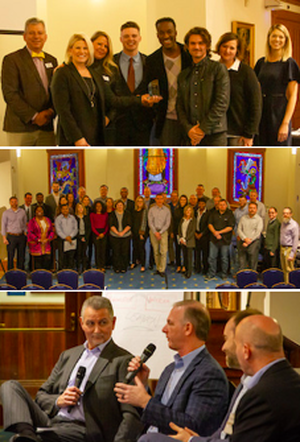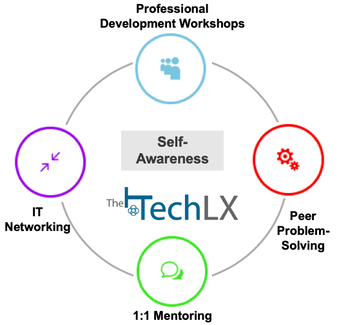 What a month it’s been! Since countries around the world went on lockdown in response to the COVID-19 pandemic, job #1 for IT has been jumping into action, getting people connected, and building capacity. The digital transformation work IT organizations have been doing over the past few years has delivered in a big way as businesses have had to pivot to remote work while making sure day-to-day operations and customer engagements continue to run smoothly. The slogan “digital first” was already gaining traction among forward-thinking companies, but this experience has proven that every company is going to need to adopt a digital first mantra going forward. With the “firefighting” of the first few weeks behind us, CIOs and IT communications leaders are reflecting on where we are now, lessons learned, and what comes next. Moving out of a strictly reactive mode, they’re looking at how to capitalize on opportunities this new business environment offers, particularly as executives are now seeing more clearly than ever the value that IT brings to the business. What follows are some of the themes shared by CIOs, senior IT leaders, and IT communications leaders in a recent virtual roundtable discussion about communicating in a crisis. For additional insights, download our report, IT Communications: 5 Lessons from an Essential CIO Partner. Overall Messaging
Leadership Communications
Digital Transformation
Challenges
Lessons Learned
Silver Linings
What’s Next?
IT’s ability to step up has created huge brand equity for IT across the rest of the organization. One of the biggest values that’s come out of this crisis is how much organizations in general took IT for granted. Now they realize IT brings tangible value in terms of collaboration, productivity, and the interconnectedness of systems and data. It’s up to IT to communicate that value in a way that speaks to the business while leading the transformation necessary to keep the organization future-focused and well-positioned for what’s to come. Learn more about marketing a technology organization and communicating IT’s value.
3 Comments
 When the average person is bombarded with 10,000 messages a day, how do you make sure yours are the ones people remember? With the digital disruption cycle now at less than three years, the digital age is going to be a winner-take-all environment where the speed of business is accelerating—and “fast” followers are too slow. Against this backdrop is a growing communication challenge: We have much more information to communicate and more channels to consider, with limited windows of opportunity, continually accelerating rates of change, and limited bandwidth to get the right messages to the right people at the right time. Today’s technology leaders have to become a voice of the brand, able to communicate effectively and persuasively to a variety of stakeholders, both internally and externally, about the value that IT delivers. Now more than ever, no IT leader can afford to neglect their communications responsibilities. The stakes are too high. In a two-part series for IT Pack, O&A’s Dan Roberts explores the 4 pillars of great communication that every technology executive must master, and he shares 5 practical tips that will help you become a next-level communicator—and a next-level leader—so that you can turn your vision into reality. Dan also had a chance to the pick the brains of a number of IT Communications leaders who are partnering with CIOs and technology executives at organizations like Asurion, Boeing, Dignity Health, Mattel, Union Bankshares, and more. They shared their best tips, takeaways, and insights on how to communicate IT’s value in a way that gets the business to stand up and take notice. Download this illuminating new report: IT Communications: 5 Lessons from an Essential CIO Partner. What are you doing to proactively change the narrative and communicate the art of the possible? With IT’s end-to-end view of the enterprise, we have an unprecedented opportunity to lead the conversation, paint a picture of the future, and drive the disruption that will future-proof our organizations.  Businesses that fully embrace digital transformation are reaping the benefits. In addition to reducing costs and increasing efficiencies, these companies are redefining and reinventing the customer value proposition to strengthen their competitive foothold and disrupt their industries in the process. And their IT organizations are leading the way. One critical factor these high-performing IT organizations have in common is their laser-like focus on building the core soft skills required to support the business and continually move further up the IT Maturity Curve. But in a hyper-digital world that’s changing at a relentless pace, the pressure to stay up-to-date with technical and core skills is mounting, and so is the pressure to retain top talent. Across the more than 3,500 diverse IT organizations O&A has worked with, leaders are increasingly concerned about whether or not they have the in-house skills and talent to support these critical business transformation efforts. A ‘digitalized terrain awash in emerging technologies’ That’s how Gartner recently described today’s business environment. While IT is leading the way on digital transformation, in this ever-changing digital climate, everyone across the organization needs to be able to embrace, understand, and use digital technologies in their work — because as McKinsey’s report on the future of work in America puts it, “The day-to-day nature of work could change for nearly everyone as intelligent machines become fixtures in the American workplace.” Closing the digital skills gap is now a top priority as companies scramble to play catch up. They realize this widening gap is not only going to hold back their digital transformation efforts; it will hold back talented employees who lack the necessary skills to adapt to the new realities of work. The upshot of all this is a growing emphasis on building digital fluency. True digital fluency involves understanding the entire digital landscape and being able to appropriately and confidently select technology to solve a business problem. Being digitally fluent often means being an effective communicator who’s competent at pushing forward an implementation and encouraging adoption. Put simply, people who are digitally fluent are able to understand and use digital technology while possessing the key soft skills necessary to drive business functions. Digital Fluency: How does your organization stack up? It’s important to design your digital fluency initiatives within the context of your current capabilities, strengths, and gaps. The IT Skill Builder platform is a great place to start for evaluating workforce data, in-demand skills, and existing talent to get a clear picture of your digital readiness. It also includes a comprehensive library of microlearning modules that specifically target these areas, from “Managing Big Data in Your Organization” to “Creating a Customer Service Culture.” Now’s the time to get serious about digital fluency! Let us know if you need help navigating this terrain. The year 2020 brings completely new IT talent challenges to organizations. In the decade ahead, technology talent will play a pivotal role in whether companies succeed or fail.
O&A CEO Dan Roberts is among the more than a dozen CIOs and talent experts who contributed their insights to a new research project from Harvard Business Review Analytic Services identifying the talent practices CIOs should adopt now to ensure their organizations thrive in the future. Download “IT Talent Strategy: New Tactics for a New Era” to learn:
Now’s the time to update your talent strategy. Download this essential report today for real-world examples of how you can attract and cultivate IT talent, develop critical skills, and build a culture that supports change. Strengthen your talent brand, future-proof your business High-performing IT organizations have a laser-like focus on building the core skills required to support the business and continually move up the IT Maturity Curve. Get in touch with us for additional resources to help you move up the IT Maturity Curve and achieve your strategic talent and business goals.
What’s it like to take part inThe Technology Leadership Experience? Participants are immersed in an in-depth leadership development journey — comprised of workshops, one-on-one mentoring, peer problem-solving, networking, and self-awareness — where they build the skills and confidence to step up to tomorrow’s C-level roles.
Over the course of the program, these emerging IT leaders develop strong bonds with their colleagues and become part of a community of leaders that will continue to support and learn from each other as they prepare for the next stage in their careers. At the graduation ceremonies for a recent St. Louis TechLX cohort, participants Andrea Gazzoli (MiTek), Jennifer Walton (St. Louis Zoo), Lisa Spahr (Maritz), Ron Borror (Alberici Group), and Cid Cardoz (St. Louis University) presented a powerful video with highlights from their journey, which you can watch below. As they share, “We know this journey may have ended; however, a new one is beginning as we take on new roles and responsibilities, mentor the next group of cohorts, and increase the ranks of the technology leadership community. Thank you for empowering us with the needed tools and bringing this awesome program to the St. Louis region.” WATCH NOW: IT Leaders, Businesses Recognized for Their Contributions to St. Louis’s IT Leadership Community12/9/2019  Awards Presentation, CIO Panel Among Highlights as 60 Emerging IT Leaders Graduate from The Technology Leadership Experience, St. Louis At the graduation program for The Technology Leadership Experience (The TechLX) in St. Louis on December 9, 2019, four emerging IT leaders and three businesses were recognized for their commitment to the growth of technology leadership in the St. Louis area. Ouellette & Associates, the company behind The TechLX, along with local partner Technology Partners, presented the following individual awards, as selected by the TechLX participants:
The Leader Amongst Leaders Awards are given to the TechLX participants who best personify the leadership qualities covered in program. The Mentoring Excellence Awards are presented to TechLX mentors who best exemplify the ideal image of a mentor. Ouellette & Associates also presented Community Leadership Awards to MiTek, Panera Bread, and Technology Partners for going above and beyond to contribute the program’s success and demonstrate a passion and commitment to nurturing and developing the IT leadership community. “The goal of The TechLX is to put high-potential IT professionals on the fast-track to leadership,” says Dan Roberts, CEO of Ouellette & Associates. “Thanks to the outstanding contributions of these individuals and organizations, it’s also helping to strengthen the technology leadership community in St. Louis and establish it as ‘the place to be in IT.’” The graduation program was the culmination of a 22-week in-depth leadership development experience for 60 emerging technology leaders from organizations throughout the St. Louis area. These leaders participated in leadership development workshops to increase their strategic business acumen as well as networking, peer problem-solving, and one-on-one mentoring with local CIOs and senior IT leaders. As part of the graduation event, a CIO panel of IT executives, including Jeff Schuchart, VP IT of Enterprise Fleet Management, David Hackanson, CIO of St. Louis University, and Mike Prusaczyk, VP Enterprise Architecture and IT Strategy for Panera, discussed how to fulfill the need for strategic IT representation in local C-suites. “In the digital era, the spotlight is on IT leaders,” says Roberts. “They have to be more than just technical experts and solution providers. They need to be strategic business partners and ‘innovative anticipators’ who can drive the business forward. The organizations taking part in The TechLX are leading the way by prioritizing the core skills, networking, and mentorship opportunities that are vital for preparing today’s emerging leaders to step up to tomorrow’s C-level roles.” The December 9th graduation, held at St. Louis University, honored participants from the first two TechLX cohorts to launch in St. Louis. Three additional cohorts are currently underway or coming soon to the area. TechLX cohorts are also being launched over the next six months in Kansas City, Mo.; Sydney, Australia; Raleigh, N.C.; Phoenix; Philadelphia; Atlanta; Southern California; Denver; and Pittsburgh. About The Technology Leadership Experience Presented by Ouellette & Associates, The Technology Leadership Experience (The TechLX) provides an in-depth learning journey for a cohort of mid-level technology leaders within a single city. Through a combination of classroom workshops, peer networking, problem-solving, and mentoring, the program does more than build the next generation of technology leaders; it creates a powerful technology leadership community. For more information, visit thetechlx.com. About Ouellette & Associates Over the past 35 years, more than 3,500 organizations worldwide in business, education, and government have relied on Ouellette & Associates (O&A) to fuel their transformation. O&A is the only professional development firm focusing exclusively on developing the human side of technology to unleash the power of IT. Through IT talent development workshops, The Technology Leadership Experience, and IT Skill Builder — a cloud-based assessment, personal development and workforce analytics platform — O&A equips IT organizations, leaders and teams for success in an ever-changing business environment. Learn more at ouellette-online.com. Talk to any CIO or IT executive who’s ever mentored an up-and-coming leader and you’ll quickly discover that they’re getting as much out of the experience as their mentees are. Not only does IT mentoring gives the executive a satisfying way to pay it forward, it’s also a great way to engage star talent, learn about new tech, and relate to younger workers.
In a recent article for The Enterprisers Project, Dan Roberts explored how both mentor and mentee can make the relationship work best and deliver a win-win all around. As part of his research process for the article, Dan spoke with two people who know first hand what makes a mentoring relationship effective. Dollar Bank CIO Bill Fortwanger and Andy Bonelli, a senior IT manager at PPG, were paired up as mentor and mentee in a recent TechLX cohort in Pittsburgh. They’ve seen just how powerful the relationship can be for both sides of the equation. Andy has also served as a mentor himself in PPG’s internal program, and many mentees go on to pay it forward as mentors themselves. In fact, research shows that 89% of those mentored go on to mentor others, contributing to a culture of learning and mentoring. How Mentoring Makes an Impact When CIOs and other IT executives volunteer to become mentors in the TechLX program, we ask them to share their thoughts on the value of mentoring as a professional development tool and what they hope to gain from the relationship. Here’s just a sampling of what these leaders have told us:
To learn more about getting the benefits of an IT mentoring relationship, be sure to check out Dan’s article, IT mentors: How to make the most of this win-win relationship. Interested in being a mentor for one of our upcoming TechLX cohorts, or just want to learn more about this powerful technology leadership experience? Email us, give us a call at 603-782-7473, or visit the TechLX website for more details. IT leaders are being asked to transform their organizations. And the answer to the question “But transform into what?” has everything to do with making soft skills the new core competencies.
In part two of Dan Roberts’ latest CIO Whisperers column, Claus Jensen, CTO of CVS Health, Sue Kozik, CIO of Blue Cross and Blue Shield of Louisiana, and Steve LeMoine, CIO of Cree, discuss how they’re tackling IT transformation from a human perspective. By sponsoring training in areas like consultative approaches, negotiating prowess, influence and diplomacy, marketing IT’s value, and providing strategic leadership, these leaders are putting the emphasis on core skills. Why? Because those are the skills that will fuel IT performance and elevate IT as a strategic partner and innovation driver in the business. Read on to learn why re-engineering your culture requires developing new core skills. Strengthen your talent brand, future-proof your business Today’s high-performing IT organizations have a laser-like focus on building the core skills required to support the business and continually move up the IT Maturity Curve. > Develop the IT skills that deliver game-changing value. Get in touch with us for additional resources to help you move up the IT Maturity Curve and achieve your leadership and talent development goals. Communication, influence, innovative thinking, customer focus: They used to be called “soft skills,” a term that makes many CIOs cringe. But today, these are by no means “soft.” They’re some of IT's most-needed core competencies.
For a new two-part CIO Whisperers column, Dan Roberts spoke with Claus Jensen, CTO of CVS Health, Sue Kozik, CIO of Blue Cross and Blue Shield of Louisiana, and Steve LeMoine, CIO of Cree, about the need for today’s IT employees to be “leaders, collaborators, visionaries,” as Jensen puts it. In part one, Dan explores why the technical skills that earned you a seat at the table won’t earn you a voice at the table. Read on to learn why IT must master a new set of core skills for high-level success. In a new column for the St. Louis Business Journal, Greg Nichols, President of Technology Partners Inc., makes a compelling case for cultivating a strong pipeline of visionary IT leaders. “The lack of IT professionals with real business leadership experience is a challenge our region must meet to stay competitive,” he observes. In fact, it’s a hard reality that’s affecting cities, communities, and regions across the country and around the world. That’s why we’re partnering with organizations like Technology Partners to launch The TechLX, an innovative six-month IT leadership development experience, in cities this fall. Scott Livingston, manager of membership platform production support at HM Health Solutions, explains that it’s about building the abstract qualities that make leaders, not just managers. He credits his participation in a TechLX cohort in Pittsburgh for contributing to his recent promotion. “I’ve learned that what you can do is only as good as the people you surround yourself with and how much you can motivate them,” he says. “It’s about creating opportunities.”  Building the IT Hubs of the Future The TechLX is launching cohorts this fall in Cleveland, Denver, Kansas City, Raleigh, Philadelphia, Pittsburgh, St. Louis, and Sydney Australia. Get in touch with us today to learn about available sponsorship opportunities for emerging tech leaders in these communities. |
AuthorWrite something about yourself. No need to be fancy, just an overview. Archives
April 2022
Categories
All
|
